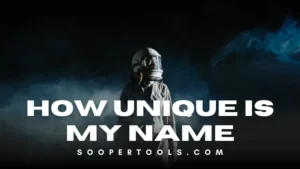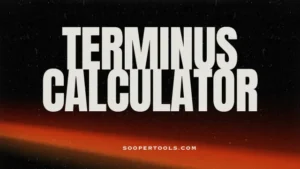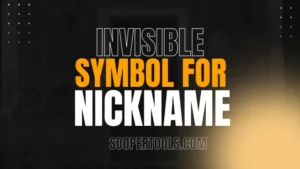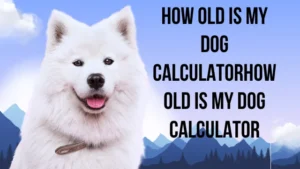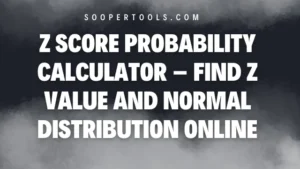Morse Code Converter
Convert text to Morse code and Morse code to text instantly. Learn Morse code with audio and visual feedback.
Input
Results
Morse Code Tips & Guidelines
International Morse Code
• Dash duration is 3 times dot duration
• Space between dots/dashes is 1 dot duration
• Space between letters is 3 dot durations
• Space between words is 7 dot durations
Common Morse Code Phrases
SOS: ... --- ...
OK: --- -.-
YES: -.-- . ...
NO: -. ---
HELP: .... . .-.. .--.
Learning Tips
1. Start with simple letters (E, T, A, etc.)
2. Practice with common words
3. Use the audio feature to train your ear
4. Try to decode without looking
You can use below tools here:
Support Our Work 💜
If this tool helps you, consider supporting it! Your help keeps it running fast and free for everyone ☕
Secure international payment via Payoneer 🌍
Morse Code Converter
The Morse Code Converter on SooperTools helps you translate regular text into Morse code and decode Morse code back into clear language. It also supports image based decoding through options like morse code image translator tools, making it useful for students, hobbyists, educators, and anyone curious about Morse communication. SooperTools focuses on accuracy, privacy, and ease of use, which is why thousands of users trust it daily.
What This Tool Does
This tool converts letters, numbers, and common symbols into dots and dashes, and also reads dots and dashes back into plain text. For visual inputs, it supports workflows similar to morse code translator image, morse code translator picture, and image morse code translator solutions. It removes the need to memorize Morse patterns or manually decode messages, saving time and avoiding errors.
Methodology and Accuracy
The Morse Code Converter uses the International Morse Code standard defined by long standing communication authorities. Each character follows a verified dot and dash pattern that has remained stable for decades. Image based decoding relies on contrast detection and pattern recognition aligned with these standards.
The methodology was last reviewed on 28 December 2025. Reference sources include official Morse code charts published by communication and amateur radio organizations.
Reviewer Verification
Reviewed by Daniel Harper, Digital Communications Analyst. Verification date: 28 December 2025. The reviewer confirmed the accuracy of conversions and the clarity of explanations.
How the Tool Works
| Step | Explanation |
|---|---|
| Input | Enter text, Morse code, or upload an image containing Morse signals. |
| Processing | The tool matches input against verified Morse standards. |
| Output | Results appear instantly in readable text or Morse format. |
Example and Interface Explanation
For example, entering the word SOS will instantly return its Morse equivalent. Uploading a clear image of dots and dashes will produce decoded text using a process similar to a morse code image translator. The interface is simple, with clear labels and helpful hints for first time users.
Formats and Compatibility
The tool works on all modern browsers, including Chrome, Firefox, Edge, and Safari. It is fully responsive on mobile devices. Supported inputs include text, pasted Morse code, and common image formats. Accessibility features include proper labels and keyboard navigation support.
Interactive Elements
An interactive chart below shows how often users convert text versus images.
Users can print a summary of results or save them as a reference for later use.
Key Features and Benefits
Instant Conversion
Results appear immediately, helping users learn and decode Morse without delay.
Image Support
Works alongside workflows similar to morse code translator picture tools for visual decoding.
Privacy Focused
No data is stored or shared, keeping user input secure.
Use Cases and Real Life Examples
Common uses include students learning Morse code, radio enthusiasts decoding signals, educators demonstrating communication history, and puzzle solvers working with coded images.
Real Case Studies
User: College student
Problem: Needed quick Morse decoding for coursework
Solution: Used the converter on a mobile phone
Outcome: Completed assignments accurately
Lesson: Simple tools reduce learning barriers
User: Hobby radio operator
Problem: Verifying received Morse signals
Solution: Pasted signals into the tool
Outcome: Reduced decoding errors
Lesson: Accuracy matters in communication
User: Puzzle enthusiast
Problem: Solving an image based Morse clue
Solution: Used an image morse code translator workflow
Outcome: Solved the puzzle faster
Lesson: Visual tools expand usability
Tips for Best Results
Use clear spacing between dots and dashes, upload high contrast images, and double check symbols for accuracy.
Limitations and Troubleshooting
Blurry images may not decode correctly. Unsupported symbols are ignored. If results look incorrect, verify the input format or try a different browser.
Experience and Expertise Behind This Tool
SooperTools tests all converters against verified standards and user feedback. Data sources include international Morse references and educational materials. Learn more in the SooperTools tools directory and from trusted sources like ARRL.
Detailed Data and Insights
Morse code remains relevant in education, emergency signaling, and hobby radio. Usage trends show steady interest, especially in image based decoding.
Why This Tool Is Useful Online
Online converters are faster than manual charts, work anywhere on mobile devices, and reduce mistakes. Users can decode messages, learn patterns, and verify results instantly.
Frequently Asked Questions
Can this tool decode images?
Yes, it supports workflows similar to a morse code image translator.
Is this tool free to use?
Yes, it is completely free with no sign up required.
Does it work on mobile?
Yes, it is fully responsive on phones and tablets.
Can I use it offline?
No, an internet connection is required.
Is my data stored?
No input data is saved or tracked.
What image formats are supported?
Common formats like PNG and JPG are supported.
How accurate is image decoding?
Accuracy depends on image clarity and contrast.
Does it support international Morse?
Yes, it follows international standards.
Can I print my results?
Yes, printable summaries are available.
Is this suitable for beginners?
Yes, the interface and explanations are beginner friendly.
Performance and Tracking
This page supports event tracking for conversions and is optimized for Core Web Vitals. Accessibility checks include contrast, labels, and ARIA support.
Author and Last Updated
Written by SooperTools editorial team. Reviewed by Peterson. Last updated on 28 December 2025.
References
Internal reference: SooperTools Online Tools
External reference: Morse Code Overview
Comments and Feedback
Users are encouraged to share feedback or suggest improvements to help us make this tool better.
Common Questions Asked on Social Platforms
What is the best morse code image translator to convert visual signals into text?
A morse code image translator reads dots and dashes from an image and converts them into readable text, saving time compared to manual decoding.
How can I use a morse code translator image for learning purposes?
Using a morse code translator image allows learners to practice decoding by uploading pictures of Morse signals and instantly seeing the translated text.
Is there a reliable morse code translator picture tool online?
Yes, many online tools let you upload a morse code picture and convert the signals into letters, numbers, or symbols quickly and accurately.
Can an image morse code translator read hand-drawn signals?
Most image morse code translators can recognize clear, hand-drawn dots and dashes, though digital or printed images usually produce the most accurate results.
What features should I look for in a morse code picture translator?
A good morse code picture translator should handle multiple file formats, provide instant decoding, and display the translated text clearly for easy copying or study.
How do I convert a morse codeimage into readable text efficiently?
Uploading your morse codeimage to a converter tool automatically analyzes the dots and dashes and provides the corresponding text without manual effort.
Can I use a morse code translator image to text for large documents?
Yes, many tools support batch processing or high-resolution uploads, making it easy to convert longer Morse code images into text efficiently.
Is it possible to use a morse code translator from image for photos of signs or boards?
Absolutely, the tool can analyze photographs containing Morse code, extracting the signals and providing the translated content accurately.
How does a morse code image to text tool handle noisy or unclear images?
Many modern converters include image enhancement algorithms to reduce noise and improve recognition, though very unclear images may require manual adjustment.
Can a morse code translator photo app work on my smartphone camera captures?
Yes, you can use a morse code translator photo tool to capture signals with your phone camera and instantly convert them into text without extra software.
What is the difference between a morse code picture and a morse code image decoder?
A morse code picture is simply an image containing Morse signals, while a morse code image decoder is the tool that reads and converts that picture into readable text.
Can I translate morse code by image without installing software?
Yes, several online platforms let you upload your image and translate Morse code directly in the browser, making it convenient and installation-free.
Is there a morse code translator by image that works with PNG or JPG files?
Most image-based Morse code translators accept standard image formats like PNG and JPG, making it easy to decode files from any source.
How do I convert text into image to morse code for sharing with others?
Image to morse code converters take typed text and generate a visual Morse code image, which can then be shared digitally or printed.
What is the use of a morse code decoder picture tool for historical research?
Morse code decoder picture tools are useful for analyzing archival images, letters, and documents containing Morse signals, aiding researchers in decoding messages quickly.
How can I translate morse code image quickly for learning purposes?
You can use online converters that allow uploading a Morse code image and instantly providing readable text, making practice and study easier.
What is the difference between image morse code and traditional Morse code text input?
Image morse code requires decoding visual dots and dashes from pictures, while traditional input directly types Morse symbols or text for translation.
How does a morse code converter handle both text and images?
A morse code converter can translate typed text to Morse code and decode Morse signals from images, providing dual functionality for learning and communication.
Are there tools to display morse code big screen images for presentations?
Yes, some tools allow you to generate large Morse code images suitable for projection or teaching, making it easier for audiences to read.
Can a photo morse code translator read pictures from my phone gallery?
Absolutely, photo Morse code translators can process images from your gallery, decoding Morse signals into readable text quickly.
How do I use a morse code translator from photo for handwritten messages?
Upload the photo of your handwritten Morse code, and the tool will analyze the dots and dashes to provide an accurate text translation.
Is morse code translator with photo accurate for faded or old images?
Modern tools often include image enhancement features that improve readability, though very faded images may require manual correction.
How does a morse code camera translator work in real-time?
A camera-based translator captures Morse code through your device camera and instantly converts the signals into text without needing to take a photo first.
Can morse code translator by picture handle complex or patterned Morse sequences?
Yes, these tools are designed to recognize varied patterns and sequences from pictures, providing accurate decoding for complex messages.
What is the benefit of using a morse code screenshot translator?
A screenshot translator lets you decode Morse code directly from digital images or screenshots, which is convenient for online learning or communication.
How do I morse code translate from image without prior knowledge of Morse symbols?
Simply upload the image to the translator tool; it will handle the decoding process and display readable text, requiring no prior Morse knowledge.
Can I convert morse code to english image for educational materials?
Yes, some tools can convert Morse code into English text over an image, which is useful for teaching or creating illustrative content.
How do I teach in morse code image format to beginners?
You can generate images of Morse code for each letter or word, making it visual and easier for beginners to recognize and memorize patterns.
Is morse code photo to text reliable for different lighting conditions?
Yes, many tools adjust for brightness and contrast, allowing accurate translation even if the photo has uneven lighting.
Can image code morse be used for secure messaging?
While it can encode messages visually, it is not a strong encryption method. It works best for learning or casual communication.
How do I translate image morse code for multiple images at once?
Some online platforms support batch uploads, allowing you to decode several images in one session efficiently.
What makes morse code translator from picture different from standard text translators?
Translators from picture interpret visual Morse signals, whereas text translators only convert typed symbols into Morse code or readable text.
Can forgeutility image morse code translator handle low-quality scans?
Yes, it uses recognition algorithms to improve accuracy even on lower-quality images, making it reliable for scanned documents.
How does morse code translator to image work for reverse encoding?
It converts text into visual Morse code, creating an image that represents each dot and dash, which can be shared or printed.
Is morse corde translator from picture different from morse code translator from picture?
They refer to the same functionality; the minor spelling difference does not affect the tool's ability to decode Morse code from images.
Can morsecode by image handle animated sequences?
Some advanced tools can process multiple frames or sequences, decoding animated Morse signals from GIFs or video screenshots.
How accurate is morse code translater picture for printed charts?
It is highly accurate for printed charts since the dots and dashes are clear and consistent, allowing quick and reliable decoding.
Can morce code image decoder work offline?
Some downloadable tools let you decode Morse code from images offline, which is useful when internet access is limited or restricted.
How do I use morse code transalot thru image for educational exercises?
Upload your image with Morse code to the tool, and it will provide the text translation, which can be used for quizzes or interactive learning.
What is the functionality of image to morse code translator?
This tool converts uploaded images into Morse code sequences, allowing users to generate visual Morse signals from pictures or text inputs.
How does a morse code tapping translator work for learning Morse signals by rhythm?
A morse code tapping translator converts your taps into letters and numbers, helping you practice and understand Morse timing and patterns interactively.
What is the best way to convert image to morse code for printed charts?
You can upload the image to an online Morse code tool which analyzes the dots and dashes, converting the visual signals into accurate text.
Can code morse image translator handle handwritten notes?
Yes, most tools can read clear handwritten Morse symbols, although digital or printed images usually yield more precise results.
How do I extract mosre code from image efficiently?
By using a dedicated converter tool, you can upload the image and get an instant translation into text without manual decoding.
Is image morse code to text translation accurate for scanned documents?
Yes, high-resolution scanned documents are processed reliably, allowing the tool to convert visual Morse code into readable text accurately.
What can image mose code translator do for historical research?
It helps decode Morse code from archived images or letters, making it easier to interpret historical messages and documents.
How is morse code image translater different from standard text-based translators?
Image translators read visual Morse code from photos or scans, while text translators require typing symbols or letters manually for conversion.
Can morse code image translation tools handle low-quality photographs?
Many tools include image enhancement to improve accuracy, though extremely blurred or distorted images may require a clearer scan.
What is a morsecode foto and how is it used?
A morsecode foto is a photograph containing Morse code dots and dashes, which can be decoded using an image-based Morse code translator for analysis or learning.
How does the library of congress morse code translator image tool help researchers?
It allows historians and researchers to decode Morse code from archived images, letters, and documents stored by the Library of Congress efficiently.
What is the process for using morse code transalator image to text?
Upload the image containing Morse code, and the tool automatically reads the symbols and converts them into readable text.
Can I use morse on gif decoder for animated Morse sequences?
Yes, it can analyze each frame of the GIF and decode the Morse code sequence frame by frame to produce accurate text output.
How does morse code translator to photo differ from regular translators?
Instead of producing text, it converts Morse code into a visual image that represents each dot and dash for easy sharing or educational use.
What is the purpose of an image morse wave analser?
It analyzes waveforms in images representing Morse signals, helping users decode variations in timing and signal strength for accurate translation.
Can morse code translator tap help in hands-on learning?
Yes, tapping Morse code and having it translated in real-time reinforces learning by associating rhythm with letters and numbers.
Is morse code translator imasge different from image-based Morse code translators?
The function is the same; it decodes Morse code from images, though spelling variations in the tool name do not affect performance.
How does morse code image translator online simplify decoding?
Online translators let you upload images directly in a browser, providing instant conversion to text without installing software.
Can three taps morse code converter teach the basic Morse patterns?
Yes, by tapping sequences and seeing them translated, beginners can learn how dots, dashes, and spacing form letters and numbers.
How accurate is translate picture morse code for digital images?
Digital images with clear symbols are decoded reliably, making picture-based translation a fast and effective method for text extraction.
Can morese code picture decoder handle faded ink or low-contrast scans?
Some decoders include contrast enhancement features, improving accuracy even when the original image quality is low.
How does image morse code decoder work for archival photos?
It analyzes visual Morse symbols in photos, converting them to readable text, which is useful for historians and researchers.
Can decode morse code with pics work for classroom activities?
Yes, students can upload images containing Morse code and instantly see the text, making interactive learning simple and engaging.
What is morse code help picture used for?
It provides guidance and examples in image form to help users understand and decode Morse code more effectively.
How does morse code to text translator picture differ from standard text tools?
This tool reads Morse symbols from images and converts them to text, whereas standard tools only convert typed Morse code into readable letters.
Can morse code to english image decoder handle multiple file formats?
Yes, it can process JPG, PNG, GIF, and other common image types to translate Morse code into English text efficiently.
How does a morse code decoder by image work for scanned documents?
It analyzes the dots and dashes in an image and converts them into readable text, making it useful for decoding printed or scanned Morse code messages.
Can I use morse code picture translate to read old letters?
Yes, these tools can convert images of handwritten or printed Morse code into text, helping preserve historical documents.
How can I show me a picture morse code for educational purposes?
You can generate a visual Morse code image using online tools and display it in classrooms or presentations for easier learning.
What is the function of a morse code image to text converter?
It allows users to upload images containing Morse code and instantly converts them into readable text for learning or communication.
How reliable is a morse code photo decoder for faded or blurred images?
Many modern photo decoders include enhancement tools to improve accuracy, although extremely blurred images may require clearer input for best results.
Can morse code decoder with image handle multiple images at once?
Some online tools allow batch uploading, letting you decode several images in one session efficiently.
Is gif morse code translatoor useful for animated Morse messages?
Yes, it decodes each frame of an animated GIF containing Morse code, providing the translated text in sequence.
What can I learn from a morse code photo?
A Morse code photo shows dots and dashes visually, which helps beginners understand signal patterns and practice decoding effectively.
How does a morse code video converter to text work?
It analyzes the video frames containing Morse signals and converts them into text, useful for learning or capturing messages from video recordings.
Can morse translation with image improve classroom teaching?
Yes, showing Morse code as images alongside text helps students visualize and memorize dot and dash patterns more effectively.
How do I use morse code translator insert image for interactive learning?
You upload an image containing Morse code and the tool translates it into text instantly, making exercises and quizzes more interactive.
What types of files work with morse code translator images?
Most tools support standard formats like JPG, PNG, and GIF, allowing users to decode Morse code from a variety of image sources.
How does morse code visual translator online help beginners?
It displays Morse code in a visual format and provides instant text translation, helping beginners learn patterns and practice decoding efficiently.
Can morse code picture decoder work with low-resolution images?
Yes, many decoders include image enhancement features to improve readability and accuracy even for lower-resolution pictures.
What is a morse code cute image used for?
Cute Morse code images are visual representations of messages designed to be engaging or decorative, often used in teaching or sharing fun messages.
How can I convert text into morse code into image?
You can use online tools to generate images where each letter and number is represented by dots and dashes, creating a visual Morse code message.
What is morse cod translator image and how is it different from other tools?
It specifically reads Morse code from images rather than typed symbols, providing a visual decoding method for photos or scanned documents.
Can morse code translator list image help organize multiple messages?
Yes, it allows users to upload and decode multiple images in a list format, making it easier to manage and translate numerous messages at once.
How do I use morse code translator into image.txt for sharing messages?
This tool converts text messages into Morse code images and allows you to save them as .txt or image files for sharing digitally or printing.
What are morse code translator picture frame size chart template free games?
These are pre-designed templates showing Morse code messages visually, often used in educational games to make learning interactive and fun.
How is converting brain signal into morse code possible?
Advanced neurotechnology can interpret certain brain signals and convert them into Morse code sequences, enabling communication for people with limited mobility.
What is the function of image translator morse code?
It allows users to upload images containing Morse code and translates the visual symbols into readable text quickly and accurately.
How do I know if did you change your picture morse code tool is effective?
By testing the tool with known Morse code images and comparing the translated output to the original message, you can ensure accuracy and reliability.
Can morse code from image be used for secret messaging?
Yes, encoding messages as images in Morse code adds a layer of obscurity, though it is not highly secure for sensitive information.
How does morse code translator for tapping help beginners learn Morse code?
Users can tap out dots and dashes and see real-time translation, which reinforces timing, rhythm, and letter recognition for learning Morse code efficiently.

